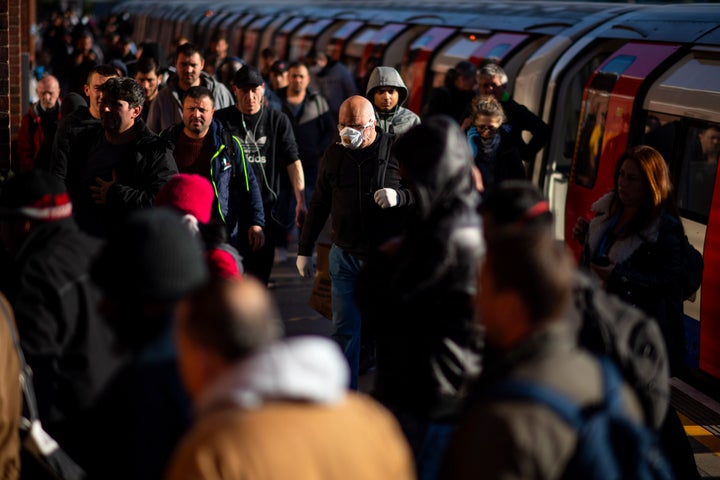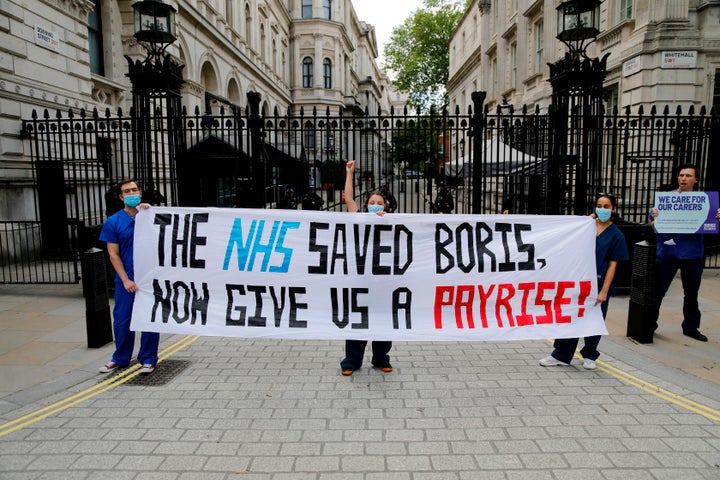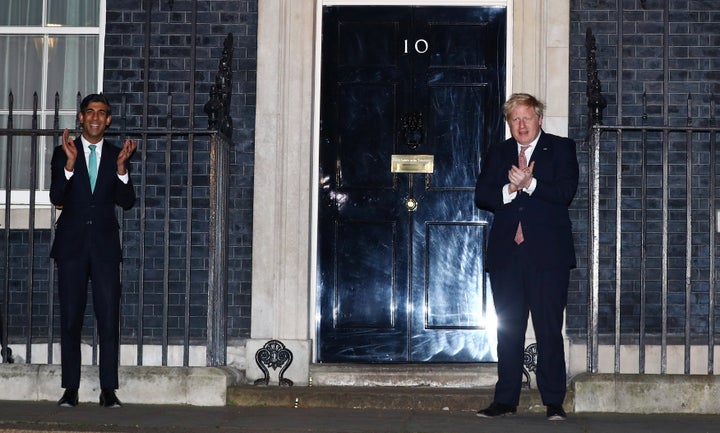Following his announcement that workers should start returning to their offices and job sites this week, U.K. Prime Minister Boris Johnson argued that the best way to curtail the spread of the coronavirus was for the public to use “good, solid British common sense.”
“I think everybody understands what we are trying to do together, and that is working together as a country to obey the social distancing rules, which everybody understands,” Johnson told Parliament.
As the U.K. and other European countries begin to ease lockdown restrictions, however, it’s clear that, despite Johnson’s appeals to national unity, the coronavirus is highlighting stark economic and class divisions.
Common sense would dictate that people avoid crowded public transportation systems, Johnson said. “Work from home if you can. … And when you do go to work, if possible do so by car — or even better by walking or bicycle,” Johnson said Sunday night from his home and office at No. 10 Downing St.
Just days later, photos and videos posted to social media showed packed buses and trains in London during the height of rush hour. Many workers, particularly those in low-paid professions, don’t have the option of working from home, delaying their commutes, or avoiding public transportation altogether.
“Social distancing during the peak was a joke,” one worker on the London Underground said on Wednesday, per HuffPost UK.
Similar scenes played out in Paris on Monday, the first day of relaxed lockdown restrictions, where HuffPost France reported that the metro was packed with riders.
Meanwhile, Grant Shapps, the U.K.’s transportation secretary, admitted on Wednesday that he wouldn’t board a crowded bus himself.
“No. People should try to avoid that,” he told the BBC.
Avoiding public transportation, Shapps argued later in the week, was a matter of “civic duty.”

At the end of March, New York Gov. Andrew Cuomo tweeted that the coronavirus is “the great equalizer.” His point was that the virus is capable of afflicting anyone — young or old, rich or poor. But the impact of the pandemic is certainly not being felt equally.
Preliminary data released by New York City’s health department last month revealed that black and Latino New Yorkers are dying from the coronavirus at twice the rate of white and Asian residents.
“There are clear inequalities, clear disparities in how this disease is affecting the people of our city,” New York Mayor Bill De Blasio said.
That is as true in Britain as it is in New York and other parts of the United States. According to data released last week by the U.K.’s Office for National Statistics, Black people in England and Wales are four times more likely to die from the coronavirus than white people.
Indeed, the figures suggest that men and women from all ethnic minority groups — with the exception of women of Chinese ethnicity — are at greater risk of dying from COVID-19 than white people.
A separate analysis this week also revealed that men in low-skilled jobs, such as security guards or construction workers, had the highest rates of death involving the coronavirus. Taxi drivers, bus drivers, sales and retail assistants, and social workers also had higher rates of death involving COVID-19.
The U.K. government’s guidance that people should start returning to work amounts to “throwing people from Black and minority ethnic communities under the bus,” Sabby Dhalu, a leader of the group Stand Up to Racism, told HuffPost UK.
“People have been put in the very difficult position of choosing to make an income by risking their life going back to work, and no one should be put in that position.”

Some companies in the United States, including Kroger, Starbucks and Amazon, have offered bonuses and modest hourly pay raises to workers who continue to clock in for their shifts during the pandemic. As lockdown restrictions have begun to ease, however, many companies are rescinding the extra hazard pay — even though the threat from the coronavirus remains.
Starbucks recently announced that, with the reopening of most of its stores, the $3-per-hour bonus for employees will end this month.
Kroger, the largest U.S. grocery chain, is also eliminating its $2-per-hour bonus for working amid the pandemic, a move that’s been criticized by The United Food and Commercial Workers union, which represents store employees.
“Taking away this hero pay from these essential workers disregards their continued heroism as they serve their communities in crisis,” a union official said in a statement.
In Britain, Boris Johnson and chancellor Rishi Sunak have joined other people standing on their doorsteps each Thursday evening to clap in support of frontline health care workers.
Now, however, the government is reportedly considering a two-year pay freeze for public sector employees to help address the economic fallout from the pandemic.

With the global death toll from the coronavirus passing a staggering 300,000 people this week, the public clearly recognizes the threat that the coronavirus still poses.
A Reuters/Ipsos opinion poll suggested that only a minority of Americans agree with protests against lockdowns in places like Michigan.
Overall, 72% of adults in the United States said people should stay at home “until the doctors and public health officials say it is safe.” That included 88% of Democrats, 55% of Republicans, and seven in 10 independents.
Only 21% of Americans say they want to resume normal day-to-day activities “right now,” according to a Gallup survey. The vast majority, 67%, say they will only feel comfortable doing so once there are no new cases of coronavirus in their state, or when the number of new cases declines significantly.
In France, which began easing lockdown restrictions this week, nearly 60% of workers hope to continue working from home, either on a regular or ad hoc basis.
In the U.K., only 44% of people support the government’s decision to ease restrictions, according to a YouGov poll released on Monday.
National leaders like Boris Johnson and Donald Trump have stressed the need to get people back to work, in order to revive their countries’ ailing economies. But the public doesn’t share those priorities
According to a survey by Kekst CNC, 73% of British people say the government should prioritize saving lives, even if that means a major recession or depression.
And a YouGov poll found that eight out of 10 people would prefer the government to prioritize health and well-being over economic growth during the pandemic — and six in 10 say that health and well-being should remain the priority even after the crisis has abated.
Over time, it’s possible that the public will settle into the new patterns of living and working that the pandemic requires. Many office workers are growing accustomed to working from home, and companies are evaluating whether they even need employees to return to a physical office space.
The flexibility to work from home is a luxury, however. Low-wage workers — the essential workers currently risking their lives in grocery stores and factories and warehouses — don’t have such choices.
And despite companies labeling them as “heroes,” it is these workers who are likely to be blamed for ongoing hardships related to the lockdowns, and who government officials view as expendable.
Already, in the United States, where meatpacking plants — which employ a large number of immigrants — have become some of the largest coronavirus hot spots, Republican officials have blamed the spread of the virus on workers’ home and social lives, rather than on conditions inside the plants.
South Dakota Gov. Kristi Noem, a Republican, told Fox News last month that “99% of what’s going on today wasn’t happening inside the facility,” discussing the closure of a Smithfield pork plant in Sioux Falls where 1,000 people became infected.
The spread of the virus happened “more at home, where these employees were going home and spreading some of the virus, because a lot of these folks who work at this plant live in the community, the same building, sometimes in the same apartment,” Noem said.
This month, during arguments about the legality of Wisconsin’s stay-at-home order, an attorney for the governor argued that restrictions were necessary, given how quickly the virus can spread. The lawyer pointed out that the coronavirus had surged through a local meatpacking plant, jumping to almost 800 cases in just two weeks.
The state’s Supreme Court chief justice interrupted. “These were due to the meatpacking, though,” she said. “It wasn’t just the regular folks.”
A HuffPost Guide To Coronavirus
Calling all HuffPost superfans!
Sign up for membership to become a founding member and help shape HuffPost’s next chapter
Credit: Source link